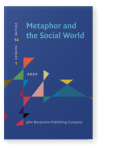Contested paths
Analyzing unfolding metaphor usage in a debate between Dawkins and Lennox
Recent studies of metaphor usage (e.g., Cameron, 2011; Semino et al., 2013) have shifted focus from relatively static mappings between source
and target domains towards an emphasis on how metaphors are appropriated and recontextualized across different genres to convey
new meanings and serve new functions. More recently, this emphasis has begun to be applied to the study of metaphor usage in
religious discourse (Pihlaja, 2014; Richardson,
2017; Richardson et al., 2021). The current article investigates how
metaphors of movement are used in conjunction with metonymy, force dynamics, and conceptual blending to create particular
rhetorical effects in a debate between the atheist Richard Dawkins and the Christian apologist John Lennox. It demonstrates how
previous figurative language is expanded and reconfigured during the course of the debate in an attempt to establish situated,
dominant conceptualizations.
Article outline
- 1.Introduction
- 2.Background
- 3.Method and data
- 3.1The data
- 3.2Identifying metaphor, metonymy, force-dynamic relationships and blends
- 4.Analysis
- 4.1Metaphor usage in the debate
- 4.2Science as a person pushing forward
- 4.3Science as a person waiting
- 4.4Religion as the driving force of science
- 4.5Atheism as being taken to the wrong location
- 5.Conclusion
-
References
References (40)
Biernacka, E.
(
2013)
The
role of metonymy in political discourse. Unpublished PhD
thesis. Milton Keynes: The Open University.
Cameron, L. J.
(
2011)
Metaphor
and reconciliation: the discourse dynamics of empathy in post-conflict
conversations. Routledge.

Cameron, L. J., Low, G. D., & Maslen, R.
(
2010)
Finding
systematicity in metaphor use. In
L. Cameron &
R. Maslen (Eds.),
Metaphor
analysis: research practices in applied linguistics, social sciences and the
humanities (pp. 116–146). Equinox.

Charteris-Black, J.
(
2004)
Corpus
appraoches to critical metaphor analysis. Palgrave Macmillan.


Charteris-Black, J.
(
2017)
Fire
metaphors: Discourses of awe and
authority. Bloomsbury.

Chilton, P., & Kopytowska, M.
(Eds.) (
2018)
Religion,
language, and the human mind. Oxford University Press.


Dawkins, R.
(
1995)
River
out of Eden: A Darwinian view of life. Weidenfeld & Nicolson.

Dawkins, R.
(
2006)
The
God delusion. Transworld Publishers.

Fauconnier, G., & Turner, M.
(
2002)
The
way we think: Conceptual blending and the mind’s hidden complexities. Basic Books.

Gibbs, R. W., Jr.
(
2005)
Embodiment
and cognitive science. Cambridge University Press.


Gibbs, R. W., Jr., & Cameron, L.
(
2008)
The
social-cognitive dynamics of metaphor performance.
Cognitive Systems
Research,
9
(1–2), 64–75.


Gibbs, R. W., Jr., & Santa Cruz, M. J.
(
2012)
Temporal
unfolding of conceptual metaphoric experience.
Metaphor and
Symbol,
27
(4), 299–311.


Hart, C. J.
(
2014)
Discourse,
grammar and ideology: functional and cognitive perspectives. Bloomsbury Academic.

Harré, R. & van Langenhove, L.
(Eds.) (
1998)
Positioning
Theory. Basil Blackwell Publishers.

Hobbs, V.
(
2021)
An
introduction to religious language: exploring Theolinguistics in contemporary
contexts. Bloomsbury.


Howe, B., & Green, J. B.
(
2014)
Cognitive
linguistic explorations in Biblical Studies. Walter de Gruyter.


Kövecses, Z.
(
2002)
Metaphor:
A practical introduction. Oxford University Press.

Kövecses, Z.
(
2015)
Where
metaphors come from: Reconsidering context in metaphor. Oxford University Press.


Lakoff, G., & Johnson, M.
(
1980)
Metaphors
we live by. University of Chicago.

Lakoff, G., & Johnson, M.
(
1999)
Philosophy
in the flesh: The embodied mind and its challenge to Western thought. Basic Books.

Larsen-Freeman, D. E., & Cameron, L.
(
2008)
Complex
systems and applied linguistics. Oxford University Press.

Lennox, J. C.
(
2009)
God’s
undertaker: Has science buried God? Lion Hudson.

Littlemore, J.
(
2015)
Metonymy:
Hidden shortcuts in language, thought and communication. Cambridge University Press.


Musolff, A.
(
2004)
Metaphor
and political discourse: Analogical reasoning in debates about Europe. Palgrave Macmillan.


Pihlaja, S.
(
2014)
Antagonism
on YouTube: Metaphor in online discourse. Bloomsbury.

Pihlaja, S.
(
2018)
Religious
talk online: The Evangelical discourse of Muslims, Christians, and Atheists. Cambridge University Press.


Pihlaja, S.
(
2021)
Talk
about Faith: how debate and conversation shape belief. Cambridge University Press.


Pragglejaz Group
(
2007)
MIP: A
method for identifying metaphorically used words in discourse.
Metaphor and
Symbol,
22
(1), 1–39.


Radden, G., & Kövecses, Z.
Richardson, P., & Mueller, C. M.
(
2019)
Moving
and being still: Exploring source domain reversal and force in explanations of
enlightenment.
Language and
Cognition,
11
(2), 310–339.


Richardson, P., Mueller, C. M., & Pihlaja, S.
(
2021)
Cognitive
Linguistics and religious language: An
introduction. Routledge.


Richardson, P., Pihlaja, S., Nagashima, M., Wada, M., Watanabe, M., & Kheovichai, B.
(
2020)
Blasphemy
and persecution: Positioning in an inter- religious discussion.
Text and
Talk, 40(1), 75–98.


Richie, L. D.
(
2008)
X
IS A JOURNEY: Embodied simulation in metaphor interpretation.
Metaphor and
Symbol,
23
(3), 174–199.


Semino, E.
(
2008)
Metaphor
in discourse. Cambridge University Press.

Semino, E., Deignan, A., & Littlemore, J.
(
2013)
Metaphor,
genre, and recontexualization.
Metaphor and
Symbol,
28
(1), 41–59.


Talmy, L.
(
2000)
Toward
a cognitive semantics. Vol. I. Cambridge, MA: MIT.

Cited by (1)
Cited by 1 other publications
Pihlaja, Stephen
2024.
Narrative and Religion in the Superdiverse City,

This list is based on CrossRef data as of 5 july 2024. Please note that it may not be complete. Sources presented here have been supplied by the respective publishers.
Any errors therein should be reported to them.
